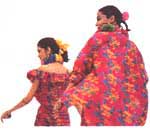|
|


The local favorite: Ghevar |
Wandering
through the bazaar's of old Jaipur is an experience
in itself, whether you buy anything or not. They are
colorful,
noisy and happily chaotic, and you can buy anything
here, from Jaipur's famous Meenakari Jewelry to Bars
of Soap, marketed under the unique promise that they
are made from holy Ganges Water, to give you a holy
Ganges water bath every time. The most interesting
bazaars lie within the Pink city quarter. The best
way to tackle them is perhaps by first taking a slow
recce by cycle rickshaw and then coming back to the
parts you find most interesting. Jaipur is known for
its delicious traditional candies.
|
A favorite
is Ghevar, a crunchy orange honeycomb like disc made from
cottage cheese. Probably the best known candy shop in town
is within the restaurant Lakshmi Mishtan Bhandar, said to
have operated from the same premises since the 18th century.
Choki Dhani en route to Sanganer is a novel "folk village"
serving authentic Rajasthan food in a charming rustic setting
complete with puppeteers, ballad, singer, bangle makers
and potters. Its sprawling campus is lit entirely by flickering
hurricane lamps. The food is served on leafplatters while
you are seated on the floor in the traditional manner.
Handmade Paper
|
If you've ever used handmade paper from India, chances
are it was made in Sanganer. The craftsman are the
descendants of those who, for generations, made paper
of the Rajput princes and the technique hasn't changed:
the raw material is ordinary scrappaper which is ripped
up, stamped into pulp by foot and washed.
|

A handmade paper factory |
Then it is bleached , dyed and very dexterously lifted out,
layer by layer.... each layer, of course being a fresh sheet.
The sheets are then dried, either by hanging them from clothes
lines or by sticking them up on the walls of the town's
houses. Finally they are smoothed out with heavy stones
and speckled if necessary with gold.
Rajasthani Textiles
|
Whether tie-dyed, woven, block-printed, appliqued,
embroidered or hand painted, use certain motifs not
generally seen elsewhere. The motifs are mostly derived
from the flora and fauna found in the region. Some
flowers, like the Marigold, Jasmine, Rose, Champa
or Raibe, have sacred associations and some animals
such as the Elephant, Lion and Monkey are considered
more important than others. Caparisoned Elephants
and Camels, Peacocks or a girl holding a flower or
in a dance pose, add more Rajasthani Character then
other motifs.
|

Famous Textile Prints |
However motifs based on geometrical forms trellises, symbolic
patterns used in age-old paintings or decoration in daily
rituals by the village women.
The mandana motifs used to decorate mud houses during Diwali
in certain parts of Rajasthan and flowers and flowering
plants are also common.
|
|
|